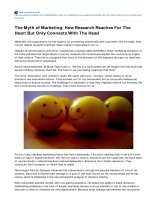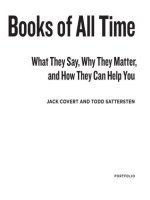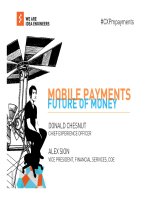the business of belief how the
Bạn đang xem bản rút gọn của tài liệu. Xem và tải ngay bản đầy đủ của tài liệu tại đây (457.87 KB, 78 trang )
Also by Tom Asacker
Sandbox Wisdom
A Clear Eye for Branding
A Little Less Conversation
Opportunity ScreamsCopyright © 2013 by Thomas E. Asacker
All rights reserved. No part of this book may be reproduced, scanned, or distributed in any printed or
electronic form without permission, except for brief passages for review purposes.
Portions of this book have appeared in somewhat different form on the author’s website.
ISBN-10: 1483922979
ISBN-13: 978-1483922973
eBook ISBN: 978-1-63002-576-2
First Edition: 2013
Library of Congress Cataloguing in Publication Data: A catalog record for this book is available from
the Library of Congress
Cover design by Paulo Reis
For my mother
Contents
PROLOGUE
CAN WE HANDLE THE TRUTH?
PART ONE: WHAT THEY KNOW
LIVING IS BELIEVING
FAIRIES ABOUND
WE CHOOSE THEREFORE WE BELIEVE
BELIEF IS A BET
BELIEF IS MIND-MADE
WE SEE WHAT WE’RE WIRED TO SEE
MINDS ARE MOTIVATED
DON’T ASK WATSON
BELIEF IS OPINION
WHOSE OPINION IS REALITY?
FEELINGS DIRECT ATTENTION
RHYME AS REASON
BELIEVING IS FEELING
CAN YOU FEEL IT?
MINDS MAKE MEANING
CLICK, WHIRR
MEMORY IS A CONSTRUCTION
WE ARE RATIONALIZERS
BELIEF IS RELIEF
MEMORIES GOVERN BELIEFS
WE THINK IN STORIES
OUR STORIES STEER OUR LIVES
LIFE IS OUR STORY
ALL STORIES EVOLVE
MINDS CRAVE CONTROL
OBEDIENCE IS NOT BELIEF
DESIRE IS THE MARKETPLACE
DESIRE IS THE REASON
DESIRES DRIVE BELIEFS
BELIEVE TO ACHIEVE
SUMMARY OF WHAT THEY KNOW
PART TWO: WHAT THEY DO
UNDERSTAND OUR DESIRES AND BELIEFS
DESIGNING BELIEF
MAKE US COMFORTABLE
AFFECT BEFORE EFFECT
PAINT THE PICTURE
DREAMS, NOT NIGHTMARES
MAKE IT OURS
FUELING OUR FANTASY
MAKE IT EASY
AS EASY AS APPLE
GET US TO ACT
TEACHING BELIEF
MAKE PROGRESS VISIBLE
POSITIVE TICKETS
EXUDE PASSION
PASSION IS INFECTIOUS
CONTROL THEIR IMPULSES
CALM THE BATON
HIDE THE HOW
WHAT I KNOW
SUMMARY OF WHAT THEY DO
PART THREE: WHAT YOU CAN DO
BE MORE CONSCIOUS
THE REAL DEFINITION OF INSANITY
IGNORE IT
WHO ARE YOU?
FLIP YOUR LID
BELIEVING IS SEEING
BEHAVE TO BELIEVE
SNAP OUT OF IT!
STAY PASSIONATE!
WHAT EVER HAPPENED TO DREAMS?
ABOUT THE AUTHOR
Every man, wherever he goes, is encompassed by a cloud of comforting convictions, which move
with him like flies on a summer day.
— Bertrand Russell
Prologue
I’m one lucky guy. Over the past twenty years my work has afforded me a behind the scenes look at
creativity and leadership in action. I’ve been involved with scores of new product launches,
countless branding initiatives, and some very powerful marketing campaigns.
I’ve helped agencies conceive ideas, travelled with skilled salespeople, advised passionate
fundraisers, and worked with leaders as they’ve rolled out defining change initiatives. And I’ve
confronted two realities that have redefined the nature of influence in today’s modern marketplace.
The first one is this: Our choices, in all areas of life, have increased exponentially (trite but true,
think cable TV). Every new product, service, cause and idea must now work overtime to capture
people’s attention. In my world, we refer to that reality as a “no-brainer.”
The second, a fact lost on many, is that people have become very distrusting and easily distracted,
making attention increasingly scarce and fleeting. Just consider the diminishing “issue-attention
cycle” of critical concerns like climate change and overpopulation. It takes a lot of money, talent and
energy to sustain people’s attention, to become one of their “comforting convictions.”
These conditions point to why today’s most forward-looking people and organizations are moving
beyond attention. They’re acutely aware that it’s not enough to simply have people know about them
and their agendas. They need people to choose them, support them, work with them, and recommend
them. In other words, they need people to believe.
Belief is an incredibly difficult concept to wrap one’s head around because, like fish in water, our
heads are swimming in belief. Beliefs touch every facet of our lives, mundane and profound, from the
religions we choose to inform our spiritual and moral lives to the products we purchase to make us
look “hot.”
In fact, existence is defined by our beliefs. They determine how we feel, what we think, the goals we
pursue and the actions we take. But most of us are oblivious to how beliefs are born and formed. This
book is about understanding belief—what it is and how it is created. And it’s about how successful
people inspire and move others, or how, in my lingo, they practice the business of belief.
Can We Handle the Truth?
There’s a Zen story about the demon Mara.
Mara is the personification of temptation and anxiety.
He seduces and frightens people.
He obscures the knowledge of ultimate truth.
Mara is referred to as “the Evil One.”
One day he was traveling through a village with his posse.
He noticed a man doing walking meditation.
Suddenly, the man’s face lit up in wonder.
He had come across something on the ground.
Mara’s attendants were quite curious.
They asked Mara what the man had discovered.
Mara replied coolly, “It’s nothing. Just a piece of truth.”
“But Evil One!” exclaimed one of his entourage.
“Doesn’t it bother you when someone finds a piece of the truth?”
Mara chuckled. “No. Not in the least.”
“Really master? And why not?”
“Because right after they discover some truth,” Mara grinned. “They usually make a belief out of it.”
Part One:
What They Know
Living is Believing
Believe nothing, no matter where you read it or who has said it, not even if I have said it, unless it
agrees with your own reason and your own common sense.
— Buddha
Siddhartha Gautama Buddha lived over 2,500 years ago in what is now Nepal. A land of tribal
people living in territorial monarchies. People who didn’t spend much time shopping, who rarely
travelled outside their kingdoms, and who never puzzled over their choices of information, media or
entertainment. It was quite possible for most of them to heed Siddhartha’s sage advice and
consciously consider their varied beliefs.
Today it’s impossible. Our modern marketplace has morphed into a dizzying kaleidoscope revealing
a surfeit of choice. When I searched Amazon.com’s book section for “buddha,” I was presented with
16,161 options. Try “reasoning” your way through that list (and as search results go, it’s a relatively
short tally).
It’s certainly possible to limit our choices, to slow down and be more mindful of everyday decisions,
but unless you’re a monk your pre-frontal cortex will ultimately be overwhelmed. The human brain
was not designed to dispassionately evaluate today’s innumerable options. If you tried, you’d end up
like this unfortunate invertebrate:
A centipede was happy quite,
Until a frog in fun
Said, “Pray which leg comes after which?”
This raised her mind to such a pitch,
She lay distracted in a ditch
Considering how to run.
So, how do we choose? What they know that you may not is that we choose what we choose because
we believe in it. And those beliefs are (or were) driven by our desires.
To appreciate this powerful peculiarity of human nature—to understand how and why it happens—is
to better know how to motivate yourself, make better decisions, and create conditions so that others
will motivate themselves to choose you.
Fairies Abound
Arthur Conan Doyle was a 19th century physician.
He studied medicine at the University of Edinburgh.
He completed his doctorate at age 26.
Doyle also liked to write stories.
Especially when business was slow at his medical practice.
During that time he created Sherlock Holmes.
The world’s greatest detective.
The most rational character in literature.
More logical than Mr. Spock.
Doyle clearly had a handle on critical thinking.
He also believed in fairies.
Little, people-like spirits.
How could the author of the quintessentially rational Sherlock Holmes believe in winged, magical
creatures?
Doyle became a devotee of Spiritualism.
A popular religion that believed the dead continue to exist in the world as spirits.
A belief system that erroneously “proved” religious claims of an afterlife.
Since spirits exist, there must be life after death.
Doyle desperately wanted this to be true.
He tragically lost his first wife to tuberculosis.
The Great War then took his brother-in-law, two nephews and several other friends and relatives.
Doyle was eventually driven into depression by the deaths of his son and brother in the flu epidemic.
His immersion into Spiritualism may have been his lift ticket out.
No one knew for sure.
Not even Sir Arthur Conan Doyle.
But his behavior changed.
His involvement in the movement intensified.
He traveled the world.
He followed the research and attended seances.
He wrote articles and books and began lecturing for the cause.
He collected a huge number of spirit photographs, including a now famous one of fairies in Cottingly.
He also received a great deal of criticism and lost many friends, including the magician Harry
Houdini.
Such is the nature of belief.
So what is it that you believe?
What do you want to be true?
We Choose Therefore We Believe
Belief is what humans do. Our personal beliefs define our choices, shape our lives and, collectively,
determine our futures. Nothing is more important than belief. If you want to change the world, if you
want to change your world, if you want to succeed at work, in the marketplace, or in any other social
endeavor or organization, belief is your Holy Grail.
Take a quick mental run through yesterday morning’s decisions. What brand of toothpaste did you
use? Did you drink coffee or tea? Which sweetener did you stir into it? Did you eat breakfast? Bacon
and eggs? Fruit and yogurt? Did you take any vitamins? Which ones? Did you watch the news? Which
network?
Keep going. Did you workout? What brand of running shoe did you lace up? Did you run? Lift
weights? Do yoga? Did you drive to work or take public transportation? What kind of vehicle did you
drive? Gas-powered? Electric? Hybrid-electric? Which morning radio show did you tune into? Did
you text while driving? Did you buckle up? Did you light up?
Whether your decisions were consciously considered or habitual, they were decisions nonetheless.
And you made them because you wanted to—perhaps they were quick or easy, or they scratched an
itch or validated a previous decision. In any case, you believed, for reasons known or unknown to
you, that they were the right decisions for you to make, at that time.
Beliefs are really nothing more than working assumptions. Most are provisional, conditional and have
varying degrees of certainty—“I know I’m not very creative. I think that walnuts are good for heart
health. I’m pretty sure that our organization is making a difference. I’m positive the Earth is round.”
We make life’s most trivial and most meaningful decisions according to those assumptions. And we
weigh them by holding desire in one hand and by placing our sketchy assessment of the risks and
uncertainties (which typically carry more weight) in the other.
It seems simple, and it is. But how and why our minds work to create and nourish our beliefs is quite
curious and largely invisible to us.
Belief is a Bet
Many adolescents suffer from mood swings.
Causes range from chemical imbalances in the body to environmental factors like stress.
Those with severe, disruptive mood swings are commonly treated with drugs.
That’s one of today’s working assumptions.
When I was growing up, psychosurgery was a mainstream treatment for mood swings.
Prefrontal lobotomy.
A physician would shock the disturbed patient into unconsciousness.
Then insert an ice-pick like tool through the eye socket, tap it with a hammer, and swirl it around.
Viola! Offending neural connections effectively scrambled in a little under ten minutes.
John F. Kennedy’s older sister Rosie was lobotomized and totally incapacitated when she was 23.
Tragically, so was Tennessee Williams’ beloved sister.
Would you allow such barbaric treatment of your moody child?
Would you be willing to make that bet?
Not today.
Belief is Mind-Made
“Believing seems the most mental thing we do,” wrote Bertrand Russell in 1921. Yet for all of our
discoveries in the fields of cognitive psychology, computer science, behavioral economics and
neuroscience, the process of belief remains an utter mystery. There is no universally accepted mental
representation of the belief concept.
And there never will be. Because belief is unique and fluid. Belief is a personal construct, an
emotionally-colored fusion of imperfect mental processes like perception and memory. Our beliefs
are influenced and reinforced by a host of idiosyncratic factors, including our present circumstances,
our mood and personality.
It’s difficult to appreciate, but our minds don’t reflect reality, like a mirror. Reality is an abstraction
and reconstruction. We create it from our sensations and impressions, colored by our past
experiences and our unique understanding of facts and events. When the Jesuit priest Anthony de
Mello wrote, “We see people and things not as they are, but as we are,” he was describing belief.
We See What We’re Wired to See
Back in my university days, my roommate called and urged me to come witness some type of faith
healer.
It was a slow night, so I rushed to the venue.
I watched as a mysterious man cut a gash in his thumb with a pocket knife.
He then healed it under cover of a borrowed scarf.
He even let my friend hold the radial artery of his arm, while he miraculously “willed” his pulse rate
to zero.
My pre-med friend was awestruck.
He talked about it during the entire, freezing cold walk home.
But I finally shut him up.
When we arrived at our room, I covertly snagged the requisite prop (a tennis ball).
Then I made my pulse stop in precisely the same way.
We were both intelligent, well-educated underclassmen.
But we had very different mental wiring.
Part of mine was formed during many solitary hours practicing close-up magic.
And so my mind was primed to see what was literally invisible to him.
On that particular night, and every night since, we experienced different realities.
Minds are Motivated
Psychology and social science experiments have repeatedly established the human brain’s seemingly
irrational behavior—incorrect assumptions, improper assessments, and inappropriate choices. But
the word “irrational” belies the fact that, unlike a passionless computer, a brain is motivated. It
desires—to conserve energy and make guesses, to avoid loss, to be liked and accepted, to appear
consistent.
To paraphrase Forrest Gump, rational is what rational wants. Reason is simply a tool to help the
brain get what it cares about (and to feel good about it). And a brain cares, first and foremost, about
itself—what’s happening in its environment and why, how it appears (to others and to itself), and
whether or not it’s safe and in control.
These hardwired biases to see patterns and make meaning, craft an acceptable and consistent
personal narrative, and exert control over its environment are the irresistible forces that influence the
brain’s creation of beliefs.
Despite today’s prevailing computer metaphor, your brain is not a fleshy machine (prior analogies
have included electromagnets, combustion engines and a water clock). Machines are cold,
predictable and soulless.
Your brain is a living, pulsating tangle of nerve fibers. A self-organizing network of trillions of
connections, customized by genetics, upbringing, expectations and experiences. Like the underground
root system of a plant, it’s growing and changing.
But, unlike a plant, your brain selects and modifies all input and makes its own, subjective sense of
things. It infuses your memory with personal meaning, alerts you, primarily, to what might harm you,
and draws you toward what’s exciting and pleasurable.
It’s powerful, but insecure. It’s fast, but error prone. It’s clever, but extremely lazy. It sees a lot, but
ignores infinitely more. The brain, as Emily Dickinson so beautifully described it, “is wider than the
Sky,” and yet it also makes us feel like isolated egos inside bags of skin.
Don’t Ask Watson
In 2011, a supercomputer named Watson beat two of “Jeopardy’s” most successful human champions.
Watson’s fifteen developers spent more than 3 years and $3 million in hardware to pull off that feat.
Watson is not your run-of-the-mill machine.
It’s one of the world’s greatest question answerers.
But don’t ask Watson if you should start a business.
It won’t have a clue.
And don’t ask Watson how to paint the night sky with the brilliance of Van Gogh.
Or how to create moving poetry like Rilke, or inspire the masses like Jesus.
And certainly don’t ask Watson if you should set yourself on fire to protest corruption.
Or throw yourself in front of an oncoming vehicle to save the life of a stranger.
As someone once said (and no, it wasn’t Einstein),
“Computers are incredibly fast, accurate and stupid.
Human beings are incredibly slow, inaccurate and brilliant.
Together they are powerful beyond imagination.”
Let us never confuse the two.
Belief is Opinion
While delivering the commencement speech at Yale University in 1962, President John F. Kennedy
noted, “We subject all facts to a prefabricated set of interpretations. We enjoy the comfort of opinion
without the discomfort of thought. Mythology distracts us everywhere.”
Our individual mythologies, our comfortable, prefabricated interpretations and sets of opinions, are
our beliefs. Whether it’s what clothes to wear, vehicle to drive, school to attend, or charity to
support, where to live, what to eat, how to pray, or for whom to vote, it’s all part of a powerful,
personal narrative—an evolving story of who we believe we are, how we believe we should behave,
and why.
This book is about that story, about how our value judgments are formed, for better or for worse, and
about how others influence them, for good or for bad. It’s about what belief is, why it happens, and
what it does.
Whose Opinion is Reality?
Sixto Rodriguez was born in the summer of 1942 to working-class immigrants in Detroit, Michigan.
For the past forty years, he’s barely scraped by doing backbreaking labor and living in a dilapidated
house.
During that same time, Rodriguez was also a rock star.
More popular than the Beatles or the Rolling Stones.
That’s the fervent opinion of millions.
In the late 60s, the once aspiring singer-songwriter cut a couple of albums.
They were commercial flops in the United States.
His dreams dashed, Rodriguez spent the rest of his life hustling for odd jobs in Detroit’s inner city.
Meanwhile his first album somehow made it to South Africa in the early 70s.
An oppressive regime ripe for its poetic protest songs.
And so it caught fire and became the soundtrack of the anti-Apartheid movement.
And Rodriguez morphed into a mythological musical icon.
Sixto Rodriguez, a workaday laborer from Detroit?
Or Rodriguez, a one-of-a-kind folk rock hero.
What you believe depends on where you are (and when).
Feelings Direct Attention
Recent theories in human judgment and decision-making, shaped by psychological and neuroscientific
research by academics like Daniel Kahneman and António Damásio, are confirming what
philosophers from Plato through Descartes and beyond have known to be true: We are of two minds.
And, as the Scottish philosopher David Hume rightly postulated, it’s our intuitive, “feeling” mind that
directs our more analytical, “thinking” mind. Our gut, rather than our head, steers our attention and
behavior.
Let’s say you’re hiking up a hot and rocky desert trail, just as the sun is beginning to set, when you
suddenly notice an ambiguous, twisted brown object protruding from the shadowy rocks and brushing
up against your bare leg. What do you do? You certainly don’t bend your face towards it to get a
closer look. You jump back! You make the meaning first—“Snake!”—and only later, if it matters to
you, do you assess that belief.
That’s how our brains evolved—by seeking patterns and making meaning, everywhere and all the
time.
We see animals in wind-blown bushes and in random cloud formations, faces in crowds and on the
moon, and prophecy in science fiction and in ancient calendars. We believe we know people’s
feelings based on their email responses or facial expressions. We imagine how something will taste
by its appearance. We hear a loud bang! and reflexively duck for cover.
Sometimes connecting the dots aids us in making predictions, like when cloud formations foretell
impending storms or a funky smell stops us from pouring milk on our cereal. At other times, we make
causal associations that are baseless. Our feeling mind has a really tough time knowing the difference.
You wear a wristband and find that your balance has improved—“It’s the ions!” You’re giving a
speech and notice the room go eerily quiet—“I’ve lost them.” You lose five hands of blackjack in a
row—“I’m unlucky.”
In fact, the wristband may have simply triggered your mind to slow down and be more conscious of
your golf swing, your reserved audience may be engaged in reflective thought, and, like many other
gambling games, blackjack is won and lost in streaks.
Rhyme as Reason
In the book “Thinking, Fast and Slow,” there’s an example of intuition bias that makes me smile.
And there’s another one that concerns me.
Here’s the first one.
“A bat and a ball cost $1.10 in total.
The bat costs $1 more than the ball.
How much does the ball cost?”
Did you think “10 cents?”
Most people do, because it feels right.
But it’s wrong, and that’s okay.
And here’s the one that worries me.
Which is more accurate?
“Woes unite foes,” or “Woes unite enemies.”
A much-cited study found the first statement easier to process and therefore more believable.
Because it rhymes!
During his closing statement to the jury, O.J.
Simpson’s lawyer made a declarative statement.
“If the glove doesn’t fit, you must acquit.”
Attorney Cochran was either very lucky or deviously smart.
Believing is Feeling
So yes, our intuition, our impulsive feeling mind, can lead us astray. But it leads us, nonetheless. It
directs our attention, informs our beliefs and guides our reflections and decisions. And when it is
proven right, through experience or analysis, we have reinforcing evidence of the value of those
beliefs. Our perception becomes our reality, and a belief is born.
Your beliefs are what make the external world appear so convincingly real to you. Everything feels
so stable, orderly and predictable. But it’s not. Your perception of reality is really an elaborate
construction. A psychological model that continuously draws upon context, memories and desires to
simulate a cohesive whole.
It’s the greatest illusion in the world, and the most difficult one to dispel. Because, no matter how
well it’s described, you simply can not see it or feel it. And yet that illusion—your unique
perspective—conditions your sensibilities and beliefs. And ultimately, it drives your decisions.









